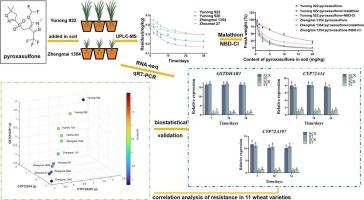Pyroxasulfone tolerance in wheat: Role of enhanced herbicide metabolism and coexpression of key metabolic genes
IF 4
1区 农林科学
Q2 BIOCHEMISTRY & MOLECULAR BIOLOGY
引用次数: 0
Abstract
Pyroxasulfone has been widely used to control malignant weeds in wheat fields. However, differences in pyroxasulfone tolerance across wheat varieties warrant attention owing to their potential impact on food production security. In this study, 54 wheat varieties were collected for screening, and Yunong 922 with 6.01-fold higher tolerance than Zhengmai 1354 was identified. Ultra-performance liquid chromatography–mass spectrometry analysis revealed that Yunong 922 exhibited a significantly shorter degradation half-life of pyroxasulfone (5.03 days) than Zhengmai 1354 (7.02 days). The P450 inhibitor malathion and the glutathione S-transferase (GST) inhibitor NBD-Cl reduced the tolerance factor of Yunong 922 to pyroxasulfone from 6.01 to 1.44 and 1.16, respectively, with no significant difference in tolerance to pyroxasulfone compared with Zhengmai 1354. RNA-Seq transcriptome analysis was used to identify candidate genes that may confer metabolic tolerance to pyroxasulfone in wheat. Eight candidate genes (five P450 enzymes and three GSTs) exhibited significantly different expression levels between Yunong 922 and Zhengmai 1354, as validated by qRT–PCR. Pyroxasulfone tolerance in Yunong 922 is associated with the coordinated upregulation of CYP72A397, CYP72A14, and GSTDHAR1, each contributing approximately 33.7 %, 32.6 %, and 33.7 % to the dominant principal component 1 that accounts for 88.7 % of the explained variance. These results revealed that the faster degradation of pyroxasulfone observed in Yunong 922 could be linked to the higher expression of P450s and GSTs, though this relationship remains to be confirmed. This study also offers valuable insights into mechanisms underlying crop tolerance and informs the development of herbicide management strategies.

小麦耐嘧磺酮:除草剂代谢增强的作用和关键代谢基因的共表达
吡咯砜已广泛应用于麦田恶性杂草的防治。然而,不同小麦品种对焦唑砜的耐受性差异值得关注,因为它们可能对粮食生产安全产生影响。本研究收集了54个小麦品种进行筛选,鉴定出耐受性比郑麦1354高6.01倍的玉农922。超高效液相色谱-质谱分析表明,玉农922对焦沙砜的降解半衰期(5.03 d)明显短于郑麦1354 (7.02 d)。P450抑制剂马拉硫磷和谷胱甘肽s -转移酶(GST)抑制剂ndd - cl使玉农922对pyroxasulfone的耐受性因子分别从6.01降低到1.44和1.16,与郑麦1354相比,对pyroxasulfone的耐受性无显著差异。利用RNA-Seq转录组分析鉴定小麦对焦唑砜代谢耐受的候选基因。8个候选基因(5个P450酶和3个gst)的表达量在雨农922和郑麦1354之间存在显著差异。玉农922对嘧唑酮的耐受性与CYP72A397、CYP72A14和GSTDHAR1的协同上调有关,分别对占88.7%解释方差的显性主成分1贡献约33.7%、32.6%和33.7%。上述结果表明,玉农922对pyroxasulfone的快速降解可能与p450和gst的高表达有关,但这种关系还有待进一步证实。该研究还为作物耐受性的机制提供了有价值的见解,并为除草剂管理策略的发展提供了信息。
本文章由计算机程序翻译,如有差异,请以英文原文为准。
求助全文
约1分钟内获得全文
求助全文
来源期刊
CiteScore
7.00
自引率
8.50%
发文量
238
审稿时长
4.2 months
期刊介绍:
Pesticide Biochemistry and Physiology publishes original scientific articles pertaining to the mode of action of plant protection agents such as insecticides, fungicides, herbicides, and similar compounds, including nonlethal pest control agents, biosynthesis of pheromones, hormones, and plant resistance agents. Manuscripts may include a biochemical, physiological, or molecular study for an understanding of comparative toxicology or selective toxicity of both target and nontarget organisms. Particular interest will be given to studies on the molecular biology of pest control, toxicology, and pesticide resistance.
Research Areas Emphasized Include the Biochemistry and Physiology of:
• Comparative toxicity
• Mode of action
• Pathophysiology
• Plant growth regulators
• Resistance
• Other effects of pesticides on both parasites and hosts.

 求助内容:
求助内容: 应助结果提醒方式:
应助结果提醒方式:


